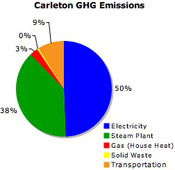Environmental Impacts
Transportation in the United States:
United States transportation plays a considerable and disproportionate role in contributing to global climate change. Despite holding only five percent of the world’s population, the United States produces one quarter of the world’s greenhouse gas (GHG) emissions and roughly one third of its emissions come from transportation. This means that the United States transportation sector is responsible for one twelfth of the world’s greenhouse gas emissions.
In addition, United States transportation trends show that vehicle usage has risen dramatically over the last 58 years. From 1950-2005 the number of vehicles in operation increased, on average, 3.1% per year while the distance traveled in these vehicles increased 3.5% per year. Not only are there more vehicles than employed citizens, vehicle purchase and travel distance rates have outpaced population growth – meaning that Americans have developed a habit of hopping in the car to go everywhere and anywhere, driving further and consuming more gas than ever before.
All of this means that although improvements in fuel economy could slow climate change, we must adjust our own commuting habits through planning, ridesharing, and other techniques. Due to a well-established and inflexible transportation infrastructure, biking, walking, ridesharing, and vanpooling to work our today’s easiest ways to reduce emissions from transportation in rural areas. Each of these commuting methods requires no infrastructure changes and can lead to tremendous greenhouse gas emissions reductions and cost savings.
At Carleton:
Carleton’s greenhouse gas emissions inventory, based on 2006 emissions data, indicates that Carleton faculty and staff emit 1,048 metric tons of carbon dioxide by commuting to campus each year. Though this is equivalent to only 4,8% of Carleton’s total greenhouse gas emissions, there is room for significant improvement. For instance, in a 2008 survey of faculty and staff, approximately 66 percent of faculty and staff indicated that they drive to campus alone. In addition, approximately 37 percent of faculty and staff live more than 20 miles from campus.
Also from 2008 data it was calculated that, on average, each Carleton commuter emits between 20 and 33 pounds of carbon dioxide emissions daily, between 100 and 165 pounds of carbon dioxide weekly, and between 3,019 and 4,957 pounds of carbon dioxide in a 30 week work year. Were one of these commuters to rideshare with one other person just one day each week, they could reduce their own carbon emissions between 2,400 and 3,960 pounds in a year. Were all faculty and staff currently driving to campus alone to rideshare, Carleton commuters would emit 2.15 fewer daily metric tons than today! At the same time as reducing emissions by hundreds of tons throughout the year, ridesharing can save those with an average fuel efficiency vehicle and a 20 mile one way commute $450 a year in fuel prices.
Not only does ridesharing to campus reduce greenhouse gas emissions, it reduces parking stress and improves air quality. With fewer vehicles on campus, Carleton can confidently protect its campus green spaces. Conversion of these green spaces to parking lots can have the effect of raising temperatures as their dark surface warms faster than land covered by grass and trees. Additionally, driving fewer vehicles on campus can improve air quality by decreasing the presence of air pollutants in the atmosphere. Beyond emitting the greenhouse gas carbon dioxide, cars and trucks release carbon monoxide, particulate matter, hydrocarbons, and nitrogen oxides – all of which are smog and/or ground-level ozone forming toxics.
